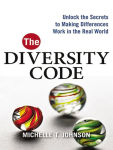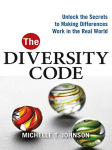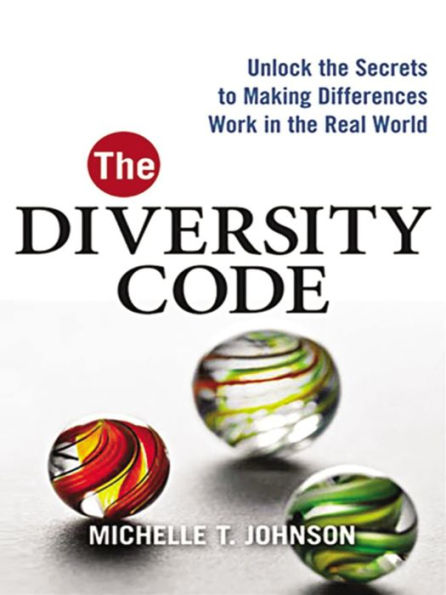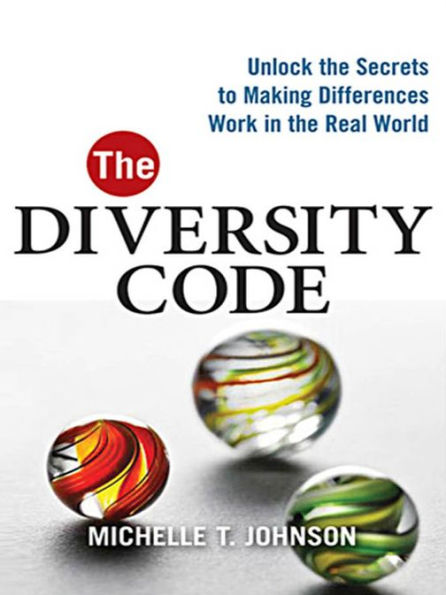Read an Excerpt
The Diversity Code
Unlock the Secrets to Making Differences Work in the Real World
By MICHELLE T. JOHNSON
AMACOM
Copyright © 2011 Michelle T. Johnson
All right reserved.
ISBN: 978-0-8144-1633-4
Chapter One
How Do You Define Diversity?
Dear Diversity Diva:
Is diversity a fancy way of saying that we all have to drink the Kool-Aid and indulge in being all P.C. so we don't hurt anyone's feelings and worry about getting sued or fired or both?
Signed, P.O.' ed About Having to Be P.C.
Deciding on a Definition
Not to get all Bill Clinton, but I feel the pain of anyone who thinks diversity is a synonym for political correctness. Diversity can be confusing, it can be irritating, and it can just straight up be a pain in the butt. But it's not just about being politically correct, or P.C.
Talking about diversity can definitely be circular, where it's hard to determine which should come first—caring about diversity and then working to figure it out, or working to figure it out so that you care. It's just like the chicken and the egg. Which comes first? The chicken that has to lay the egg or the egg that creates a new chicken? Ultimately, though, does it matter which comes first?
I do know this and so do you: It is confusing to know what is current and "correct" with every group of individuals who bond over an identity and with every issue that attracts a group of individuals. Is it black or African-American? Is it disabled or handicapped? Is it Hispanic if I know that someone is a Mexican-American? What's the difference between gay, lesbian, bisexual, and transgender? And why can I call a rug Oriental but not a person? Hey, even for those of us who deal with it all the time, it can be confusing!
What is the real issue here? Does it matter knowing why diversity is important, or is it more crucial to know what diversity is?
For me, diversity starts with a definition, because if you do not like how I define it, you will not bother to decide whether the topic is important anyway.
My Definition of Diversity
My personal definition—after years of talking about it, writing about it, litigating it, mediating it, and just thinking about it whenever I so much as watch a television commercial—is the following: Diversity is seeing the differences, distinctions, and dividing lines of others with a soft gaze but with clear vision.
That's my personal definition, which I think works as a great starting point for what diversity is and what diversity is not.
When I say "seeing the differences," I mean the obvious, usually immutable ones—differences of race, color, gender, national origin, sexual orientation, and physical abilities.
When I say seeing "distinctions," I'm talking about the distinctions between the differences. I'm talking about understanding that an East Coast lesbian who is black with a Jewish mother might be having a different life experience than a married black woman who is Southern born and raised. To the naked eye, you may just see two black women, but by seeing their distinctions, you see that they very well could be worlds apart in the key ways they look at the world and operate in the workplace.
When I say seeing "dividing lines," I'm talking about the life choices that define how people live their lives—the dividing lines where people decide on their political parties, their leanings within the parties, their positions based on religion and family upbringing, and sometimes even whether you swear by bottled water versus tap.
Seeing Without Judgment
When I say in my definition of diversity that one should see "with a soft gaze but with clear vision," it's a fancier way of saying that we should see others without judgment.
Actually, in all fairness, when I say "without judgment" what I really mean is with an awareness of the fact that you are judging and questioning yourself as to whether judgment in a particular situation is relevant, let alone fair. We all judge, whether we want to admit it or not. With workplace diversity, however, it's a matter of whether judging serves any legitimate purpose.
Let's say you see an apple in a fruit bowl. Depending on where you are, you first decide if it's a real apple or one of those tricky decorations that's so realistic looking you might accidentally bite into it. You decide it's an apple—a real apple, not a fake apple. And you decide it's an apple—as opposed to an orange or a banana or a potato or a tomato—before you get to anything else. You don't have any angry attachments or sad feelings about deciding whether it's an apple.
Now, if you're hungry and you don't like apples, you might be irritated that the bowl holds apples instead of fruit that you do like, but that thought comes after you look at the object and decide that it's an apple. A picky person might argue that you're "judging" apples if you're irritated that the bowl holds apples instead of kiwi. But if the point is deciding whether you want to eat what's in the bowl, then the judging holds a legitimate purpose if you don't want to eat apples.
When it comes to people, it appears that as a society we increasingly rely more on judging others. This is because the more we encourage and encounter differences in our society, the more we have to make ourselves feel safer by judging what we think others are about.
So while seeing with a soft gaze but with clear vision is easier to do with a bowl of fruit, it's far more important to do with the people you work with and manage.
The Heart of the Matter
At its heart, diversity is not about what you say or what you do. It is about how you think. And how you think is what determines what you say or do. The diversity code presented in this book is about giving you mental tools to change your thinking about diversity so that you have a better chance of creating, working in, and managing workplaces that succeed. In other words, workplaces where people are not constantly engaging in battles of perspective, viewpoint, and will based on ego that end up turning into complaints, lawsuits, and generally unproductive environments where there is more frustration and resentment than cooperation.
Most people hate thinking about diversity when they feel the topic is forced upon them. When it comes to diversity in the workplace, just put out a memo announcing a mandatory diversity seminar, workshop, or training session and see how loud the groans get. Sure, there are a few people who look forward to a diversity get-together either because they think it's an easy way to get out of work for a few hours or they genuinely believe that the meeting will get to the heart of whatever diversity issues they have observed. These people are the minority, though.
One of the reasons why diversity can be a touchy if not downright divisive topic is that it is all about your perspective, and what often happens with perspective is that most people don't see any other way of looking at a situation other than through their own eyes. Therefore, when someone has a different perspective, the presumption is that the other person or group is being deliberately contrary or willfully insensitive.
The great modern-day philosopher Woody Allen once said, "The lion and the calf shall lie down together but the calf won't get much sleep." Where diversity can get weedy is that people are often surprised by which people view themselves as lions and which view themselves as calves. Groups with more power, for example, often express that they feel "held hostage" by the concerns of various minority or special interest groups— as if they will always be held in the wrong no matter what because of their historic power and larger numbers. That's why part of what The Diversity Code aims to teach is how to talk to people so that you can figure out where they are really coming from and not just where you presume they are coming from.
Opposites Can Distract
Another way of looking at how to define diversity is by looking at it through its opposite impression. The opposite of diversity is not sameness, blandness, or monotony, the way most people think it is. But those descriptions are close. Instead, the opposite of diversity is norm or baseline. Basically, when people think about whether a workplace is diverse, they have in their heads a subtle, hazy thought of what they expect a place to look like, and then anybody added in who is different is considered to have made the place diverse.
Take, for example, going to the hospital to see a doctor. Assume that the hospital is in a "good" neighborhood, the doctor has been recommended by friends or an insurance company, and you have zero prior knowledge of the hospital. Usually, at the back of your mind (unless it's an OB-GYN), you expect the doctor to be a white male. Why? Because despite the recent advent of shows like Grey's Anatomy (which features doctors who are not white, not male, and sometimes not either), that's what we've been socialized to expect from being reared on everything from television shows to movies to most people's life experiences. (As an example of how deep that expectation can manifest itself, a colleague of mine said that when she put herself through school and worked at a hospital reception desk, she was surprised at the number of people who specifically requested that they did not want a doctor who was a member of racial minority group. The reason voiced by the people who gave a reason was the assumption that white doctors were better.)
When you have a child and take him to a new grade school and meet the first-grade teacher, you expect the teacher to be female. Why? Because that's what we've been socialized on. My point isn't about racism or sexism. It's about expectations of what we think the norm is.
If you go to an Indian restaurant, love the food, ask to meet the chef, and find out it's a seventy-two-year-old Puerto Rican woman, you're going to be surprised. That's not what you expected. It's not what you expect to be the "norm" for people cooking in an Indian restaurant.
Ironically, the more varied and different our society gets, the more we rely on the mental norms in our head to allow us to bounce gracefully from one situation to the next. But in the workplace, having expectations of what the norm should be gets you into real trouble because, theoretically, the doors of employment are open to everyone.
I've always described the U.S. workplace as a busy intersection rather than a melting pot. If you can't stand those "damn gays," guess whom you're going to have to deal with as your next department head? A "damn gay." If you don't quite trust anyone from an Arab country, you're going to have quite the dilemma when you enter a new position and discover that a very Arab-looking person is your administrative assistant, and your employer makes it clear that no change is allowed.
You can pick the people you date, the people you may eventually marry, your neighborhoods, your friends, your places of worship, and your social clubs, but just like with family, you can't pick who will compose the landscape of your work day. At least with family, you can avoid certain people until you have to attend funerals, weddings, and reunions. But with the workplace, you have to learn to work it out for about forty hours a week.
Especially in certain parts of the country where people are more limited in how they view diversity, white guys can sometimes be heard to say, "But I don't have diversity, I'm just a white guy." First of all, that assumption is false because the underlying implication is that white males are the norm, and thus they can never be the ones providing diversity to a situation. Second, another key reason why the analysis falls short is that the implication is that their race and their gender are the only identifications that define them.
Everyone Has a Story
I inherited my grandmother's gift (and sometimes curse) of having perfect strangers tell me their life story within about thirty seconds of meeting me. As a newspaper reporter, an employment litigation attorney, and a diversity consultant and writer, this has certainly come in handy over the years.
One Christmas Day, I was sitting next to a woman in a restaurant as we waited for our respective relatives to meet us. She and I struck up a conversation. I could tell from the context of the conversation that she was about my mother's age, but while my mother looks years younger than her chronological age, the woman looked years older.
In our short time together, I learned that she had two kids—a daughter who died at age 40 from lupus after a long bout with cancer that she had beaten, and a grown son she and her husband weren't speaking to, and thus were not spending Christmas with because of an ugly fight with their daughter-in-law.
This woman was a different race from me, was from a different generation, and clearly had a host of life experiences I have never had and would never have. She was very sweet despite her sadness mixed with a tinge of anger, and the last thing she said to me was, "Thanks for letting me dump on you. I know everyone has a story."
As I thought about that brief encounter and what the woman had said, it hit me that "everyone has a story" is the seed of what diversity really is about. You can't know everybody's story in the workplace, and oftentimes it's not even appropriate to know. But understanding and accepting differences is about having compassion for the humanity of the people you work with that seeps through even the smallest interaction.
Too often, people feel they have to "approve" of a difference before they can treat it as important. And that's not what diversity is truly all about. By "approve," I mean that most people feel as if they have to understand a difference or at least value the difference before they are willing to accept it as a valid difference. A big example of this is physical disability: If you can see that a person walks slowly with a cane, then it's infinitely easier to accept that she can't walk as quickly with you to an impromptu meeting as someone who doesn't walk with a cane. You can accept the physical limitation because it's visible, it's understandable, it's beyond the person's control, and it probably doesn't conflict with any existing value you have.
But many differences aren't that cut-and-dried, and thus, the issue of approval comes in. Let's say you're dealing with someone who speaks with an accent because he is a first-generation American whose parents are from another country. This difference may be obvious, understandable, and beyond the person's control. But some people have strong opinions about immigration laws, assumptions about people being illegal immigrants, and irritation that members of particular groups are competing with members of their particular group for opportunities in the workplace. Thus, some people won't approve of this difference.
A less essential example is how one views animals. It makes no difference whether you agree that or approve of how a dog is not a cat—but failure to understand that a difference exists and acknowledging how that difference manifests is the difference between having a healthy, thriving, loving pet or not. Some people don't like dogs, some don't like cats, but there is rarely any conflict of values associated with identifying whether an animal is a dog or a cat.
Most people don't come to work and put on their "working" hat, which excludes all their references points. Instead, when individuals are at work, they come in wearing their "people" hat, and it's one they can never take off. They can't take off the clothing of their upbringing, their various group memberships, the individual experiences they've lived through, and certainly not the last thing they may have heard on the car radio or their cell phone podcast before they entered their work space.
All of these experiences are an influence, and influences affect the effects of diversity in the workplace.
The Power of Opinions
In trying to break the code of diversity in the workplace in any meaningful way, one must remember the power and the impact of opinions. Everyone has them about every little thing.
In the workplace, opinions can be a dangerous thing when it comes to diversity because oftentimes the opinions are about people. Worse, about categories of people. Opinions can be completely insidious and damaging because facts falter in the face of strong opinions. People hold on to their opinions with the fierceness of a parent holding on to the hand of a toddler in a moving crowd.
There are a number of ways that people attempt to discount, dismiss, or dismantle the opinions of others that they don't like.
(Continues...)
Excerpted from The Diversity Code by MICHELLE T. JOHNSON Copyright © 2011 by Michelle T. Johnson. Excerpted by permission of AMACOM. All rights reserved. No part of this excerpt may be reproduced or reprinted without permission in writing from the publisher.
Excerpts are provided by Dial-A-Book Inc. solely for the personal use of visitors to this web site.






